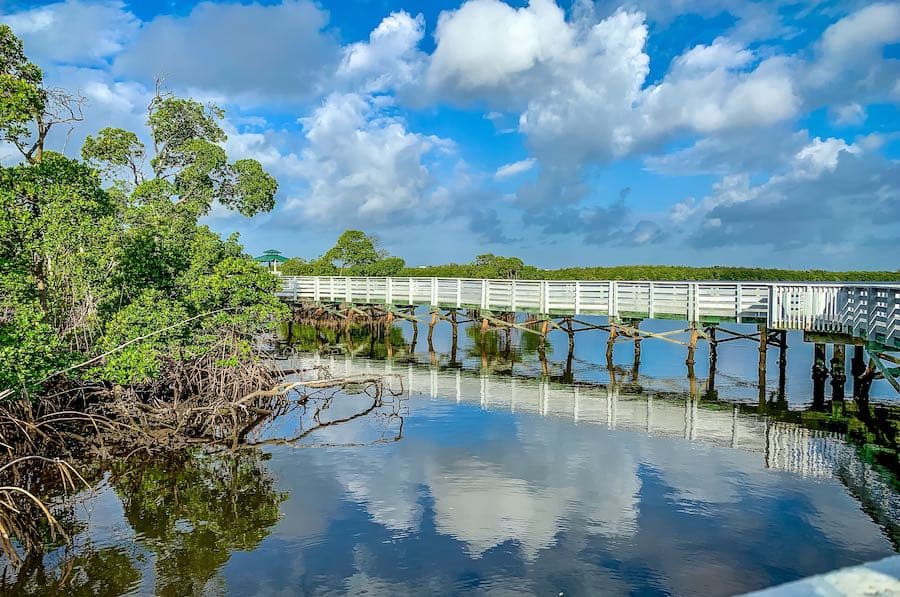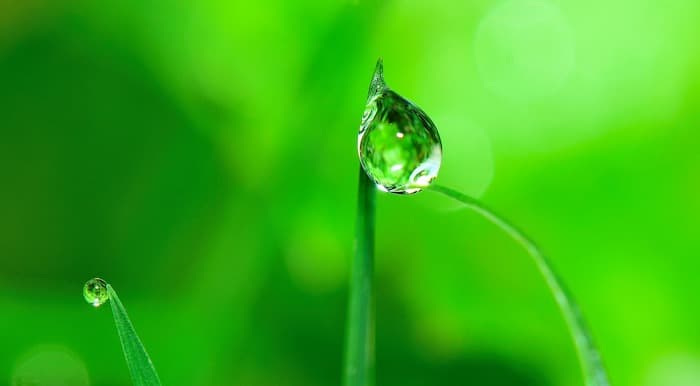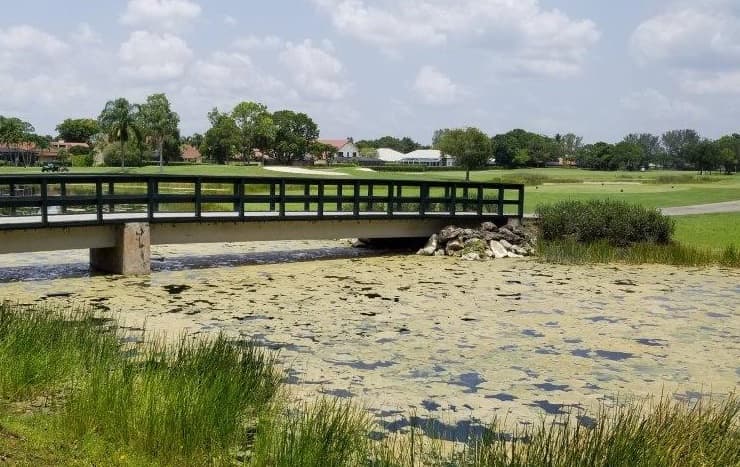
In a previous blog we asked what was actually happening with the climate in Florida and considered the impact of a changing weather patterns and the advent of more frequent extreme weather events in recent years.
In this commentary, we’ll examine the topic further, looking in more depth at the ways in which communities, individuals and businesses can take action to mitigate the impact of extreme weather and in particular the drought-to-flood conditions we're seeing more often in Florida.

One of the challenges any irrigation system must be built to handle with accuracy, is the variability in irrigation requirements at any given time for any given landscape. It must work equally well during extended periods of hot dry weather and little rainfall - and those times when hurricanes or tropical storms result in huge amounts of rain falling over a very short period. An irrigation system that isn’t flexible and responsive enough to deal with these extremes is one that's going to fail to maintain the landscape it’s intended to serve; and levy huge costs on the owners in the process.
We see the results of poorly configured irrigation systems only too often. Most frequently we see this manifested in many tens, or hundreds of thousands of dollars being spent on replacement turf year after year - or through constant but ineffective repairs, and problems that remain unresolved; we can add to this the subsequent millions of gallons of water wasted annually.
The changing climate and the hugely negative impact which water shortages can have on a community is just one of the reasons why an irrigation system without the ability to cope with the extremes of the Florida climate is never going to be fit for purpose.
As well as the practical impact of an under-performing irrigation system and the extra costs imposed on owners and users alike (wasted water and constant repair and maintenance costs), failing and under-performing systems fall short of the requirements set out by the Water Management Districts (WMDs). These bodies work to manage the natural water resources across Florida, protecting communities from risks such as flooding at the same time as encouraging the sustainable use of water and a responsible approach to irrigation. Far from seeing restrictions in the negative, we believe they're necessary - and a driving force for a less wasteful and profligate attitude to water.

The policies adopted by the WMDs, for example the South-west Florida Water Management District, St Johns River Water Management District and South Florida Water Management District are built around metrics such as minimum flows and minimum water levels. These are based on data gathered from water sources - aquifers, surface watercourses and other water bodies.
The levels of lakes, wetlands and aquifers are constantly monitored against established minimum levels, and the same applies to the flow of sources such as rivers, springs, and streams. These minimums represent the level below which the WMDs feel the water resources they manage, and the wider environment, would start to be damaged. In order to maintain these levels, the WMDs impose a raft of regulations, ranging from the issuing of strict water use permits for gated housing developments and other construction projects for example, to setting rules on water use by individuals for activities like lawn watering and car washing.
At the time of writing, for example, the South Florida WMD sets mandatory restrictions which mean that some areas have a two-day per week watering restriction while some have a three-day per week restriction, with the days upon which lawns can be irrigated dependent upon whether your house number ends in a 1, 3, 5, 7, 9 or a 0, 2, 4, 6, 8. There are exceptions to these rules for hand watering or the use of reclaimed water, and different standards also apply to sporting facilities like golf courses, football, baseball and soccer fields and so on.
In some cases, the differing demands placed on an irrigation system across a large scale development will mean that water must not only be moved from a source to the area that needs irrigating - but also between various sources - each of these with different needs.
It stands to reason therefore that an irrigation system must be designed and installed with not only the natural environment and local conditions in mind but also the regulations that are in place to protect that environment.
In today's climate, any irrigation system - from source to sprinkler must be completely scalable and smart. Our belief that technology is key to a more sustainable future for irrigation means Hoover's Flowguard irrigation control system lies at the heart of every system we build.
It means every pump station is managed intelligently; it's the only way to ensure a system not only endures but allows users to benefit from consistently high standards of water and energy efficiency for years to come.
Here are some examples that demonstrate what a best-in-class irrigation monitoring software like Flowguard can deliver. Scalable by design, Flowguard is on duty round the clock allowing users to access data about their system via a real-time dashboard, monitoring everything from pump cycle times to minute-by-minute flow rates. They can review previous water cycles, monitor water use, and view detailed diagnostic data for unusual events like power failures, problems with rapid cycling or periods of high water usage. Users can shut the system down remotely and even access data on things like water salinity for example.
It's also extremely effective at monitoring the levels of not only an irrigation lake but will signal the requirement to recharge or replenish the lake from a recharge source when the water level drops below a pre-determined minimum. An additional measure which can be taken when a large-scale irrigation system is being installed is to move water from a wastewater treatment plant to a dedicated irrigation lake, in a way that allows the client – whether that’s a developer, HOA or someone running a golf club – to manage and conserve the water in all sources and meet any sustainability targets they have set for themselves.
The need to conserve water in this manner was underlined recently when April 2023 saw central Florida hit by the worst drought conditions since April 2020, with Orlando, Melbourne, Sanford, Daytona Beach and Leesburg among others, all experiencing between 4 and 7 inches less rain than they would normally expect.
Taking the kind of long-term view needed when dealing with any climate-based policy, it’s clear that the demands placed on the sources of Florida’s fresh water – in particular, the Florida aquifer and the Everglades – will continue to grow. Here's a hard-hitting statistic. According to a National Geographic magazine article on the demands being placed on the Florida aquifer, more than 900 people a day relocate to Florida, meaning that more than 300,000 extra people per year are making demands on an already over-stretched water supply.
And here's an example of how this increased demand is affecting the all-important Florida aquifer. Silver Springs, located in Ocala and is one of the largest springs to flow from the aquifer. Studies show that the flow rate of this spring has dropped in recent years from a high of 500 million gallons per day to its current output which is 60% lower. In simple terms, if the aquifer cannot continue to be refreshed in the usual way - for example by the natural flow of rain water filtering through the porous ground – then the flow of water through everything from springs, to economically vital waterways like the Hillsborough River in Tampa, is impacted.
A drop in the pressure of water travelling through any irrigation system, natural or man-made, can lead to a drop in the quality as well as the amount of water available for irrigation. Slow-flowing water is more likely to suffer from the formation of more algae and the settling of more debris, leading to the kind of brackish, stagnant water that can harm plants and wildlife and damage delicate irrigation equipment such as sprinkler heads.

That’s just one reason why more sophisticated, high quality irrigation systems opt for disc filtration over screen filtration when drawing water from a natural source.
Disc filtration utilizes a stack of discs designed in such a way that the debris contained in any water passing through the filter is stopped by the ridges and gullies along the surface of the discs. Disc filters are excellent at catching the kind of fine particles – such as slime, sand, bacteria and chemical sludge – that can go on to block or damage an irrigation system further down the line. Far more so than screen filters which easily become clogged with moss, algae and other organic hazards. Disc filters are also easier to clean - despite their seeming complexity. The use of the right filter in a system, dictated by the kind of material more likely to be present in the source water, is just another example of the minutiae of irrigation design which can be used to maximize efficiency and conserve precious resources.
Other examples of attempts to deal with the changing climate in a way which still preserves the natural beauty of the environment in Florida focus on the basic design of that environment. Researchers from the University of Florida Institute of Food and Agricultural Sciences (UF/IFAS) worked with developers in the Weslyn Park and Del Webb Sunbridge neighborhoods to test out theories relating to the plants used to landscape such homes and the replacement of traditional turf lawns with the use of plants native to Florida and naturally more resistant to drought.
As well as changing the types of plants placed around new homes the research looked at the benefits of adding compost to the soil after the development was completed - but before anything was planted (something which is usually not done, leaving plants to struggle in the generally poor, post-development soil). They speculated that this would improve the health of the plants and mean more flowers and greater levels of pollination in the future.
The earliest results from the study – which compared two geographically proximate neighborhoods, one using traditional methods of planting and the other testing the new approach – proved to be highly encouraging. It was estimated that the alternative approach to landscape design on the first 300 homes built was sufficient to save between 39,000 and 146,300 gallons of water per day through a reduced requirement for irrigation.
An approach of this kind, particularly when scaled up across a large development, a sports venue - or in the grounds of a business like a shopping mall, could play a huge role in reducing the demand on Florida’s natural water resources as well as the cost of irrigation, but it will only work if the irrigation system in question has precise and wide-ranging monitoring technology in place.
Wider recognition of the role which the climate will play in building and landscape design in the future is demonstrated by the growth in the number of ‘climate-proof’ towns appearing in different parts of the country. Here in Florida, for example, Hurricane Ian, which hit the southwest coast in September 2022 as a Category 4 storm, left the 4,600 residents living in Babcock Ranch virtually untouched. Not only did the buildings survive physically – to such an extent that they could be used to shelter residents from surrounding communities – but they were also able to rely on continuing power supply and even internet access.
This was because, from the very beginning, the development had been planned with climate resilience at its heart. The location was 20 miles inland and 30 feet above sea-level to protect from storm surges, while all power lines were buried underground, and drainage was combined with natural vegetation to control and soak up any water flowing over the landscape. The same kind of thinking has been applied to the drought resilient communities to be seen in Utah or those built with wild-fire protection and mitigation in California.
We think a change in thinking is vital. For example, as well as their vision for the landscaping, developers will need to stop opting for a cookie-cutter approach to irrigation design. A boiler-plate approach to the design of a system has never resulted in long-term success. We're often approached with a checklist of “must have's” for a new pump station or a list of components and system requirements based on a project with entirely different need. Every single project should have its irrigation system configured and optimized to the specific nuances and differences of the location. Without this fundamental change at the proposal stage, householders, businesses, and organizations are not going to withstand the inevitable costs associated with a poorly designed and inefficient system - no matter how new it is.
In order to succeed and thrive, large-scale landscaping of this kind hinges upon a holistic approach to the installation of an irrigation system. As a company, Hoover has had irrigation system efficiency and effectiveness built into its ethos from the start. But we also know it's critical that businesses and organizations look beyond pumps, wells, sprinkler heads and pipes and so on (vital though all these components are) and consider the environment from the ground up, if you’ll pardon the pun.
In addition to the above, of course, the landscape design must take factors such as the quality of the soil and whether it needs enriching before landscaping takes place, the type of plant which is best suited to the location and other localized factors such as the wind being likely to hit a specific corner of a development (and therefore the need to choose plants for that corner which cope well with windy conditions).
Native Florida plants are always more likely to be able to cope with the mercurial nature and extremes of the Florida climate, even as the shifts become wider, while larger, low growing plants can cover more ground with fewer individual plants, and that means less maintenance and watering. Evergreen shrubs tend to be hardier than some others and plants should be grouped so that those with similar water requirements are located together, simplifying the demands placed on any irrigation system. Natural mulch such as pine bark or straw can be used on soil beds to protect roots from the heat of summer and the cold of winter and also help the soil to ‘hold’ more water by minimizing run-off. Steps of this kind will all play a part in the future regulation of irrigation across the state.

A similar approach is now being applied to golf courses around the world, with some California golf courses utilizing innovative technology that enables hydrogels injected into the turf to store and release water slowly (some say this is reduced the need for irrigation by as much as 50%), while Woburn golf course, in the UK, opted for more traditional solutions, such as creating a reservoir to catch and store rainwater and drilling a new borehole.
From property developments to golf courses and beyond, it’s clear that landscaping across the globe – but particularly here Florida – will only be able to thrive in the future if it is designed and built with due respect paid to the impact of a changing climate, and that the design and installation of irrigation systems which get the job done in the most efficient and sustainable manner will be a key aspect of paying that respect.